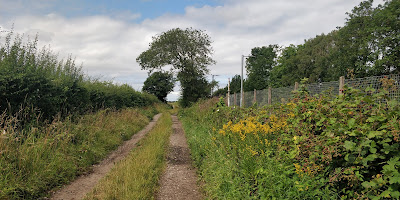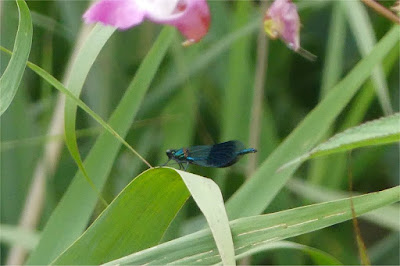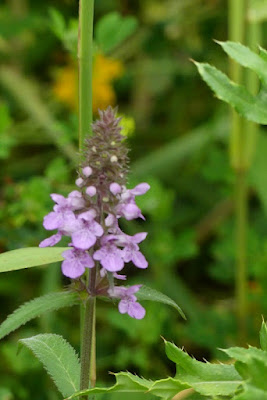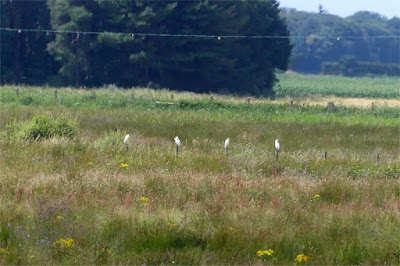 |
| Moorhen chick |
It looked like being a fair day so I decided I'd best go and visit Martin Mere before something else puts me off. The trains out of Oxford Road tried their best. I think I eventually got the Blackpool train to Bolton I was aiming for but I really wouldn't swear to it. In the midst of a signals meltdown everything had to stop to let a fifty-seven bogey freight train pass through.
Anyway, I had a nice journey from Bolton to New Lane. It's that time of year when there'll be more photos of butterflies than birds, reflected in the kaleidoscope of peacocks, red admirals and large whites in the trackside buddleias. The fields on the way in were full of rooks, jackdaws and woodpigeons, which is how it should be this time of year.
 |
| New Lane Station |
At New Lane Station the spadgers chirruped in the hedges, goldfinches twittered in the trees and greenfinches sang from the telegraph lines.
 |
| Gatekeeper |
It was a muggy sort of day and the path was awash with butterflies. Large whites, gatekeepers and speckled woods fluttered about the hedgerows, peacocks and red admirals fed on blackberries. As the path led into the open country of the potato fields common blues and small whites skittered about the verges and it was a miracle I didn't tread on any meadow browns.
 |
| Linnet |
I was glad to move upwind of the water treatment works. There weren't many black-headed gulls about but there were plenty of magpies, woodpigeons and pied wagtails on the pans. Whitethroats sang in the trackside hawthorns and a linnet sang from the wires. Reed buntings and skylarks fossicked about in the potato fields, calling every so often so that everybody could be accounted for. A migrant hawker patrolled the nettles and cow parsley along this side of the railway line, zigzagging past me before returning for a second look.
 |
| Fennel |
Somewhere in the trees by the farmstead a young buzzard was loudly begging for food. An adult floating over the trees by the water treatment works didn't seem to be paying any attention.
 |
| Grayling |
Approaching the fennel field graylings and small tortoiseshells joined the collection of pathside butterflies. That there were a lot of small birds rummaging about in the fennel was pretty obvious by the movement of stems and the occasional call. What they all were is anybody's guess. I saw linnets and whitethroats and heard more linnets, some goldfinches, blackbirds, meadow pipits and a chaffinch. A small brown bird saw me and disappeared into the depths with an alarm call I've never heard before and I've no idea what it was.
 |
| Small tortoiseshell |
 |
| Walking from the railway line to Martin Mere |
I crossed the railway line and tiptoed carefully through a carpet of meadow browns. The field was a blanket of thistles liberally peppered with peacock butterflies. Small flocks of linnets and goldfinches appeared and disappeared at random. A brown hawker patrolled the patches of tall grass, catching the small flies dancing in flight above the stems. I took some convincing that the reeling grasshopper warbler wasn't actually a grasshopper. A kestrel kept a watching brief in the dead tree by the collapsed shed. A sedge warbler sang from a bone-dry land drain.
 |
| Kestrel |
 |
| Stonechat |
I'd had better views of the pair of stonechats from the train the other day. I kept hearing them but wasn't seeing them until the male lost patience and escorted me off his patch. As I approached the gateway onto Martin Mere's external reedbed walk a stoat galloped across the path and disappeared down a rat run in the grass.
 |
| Banded demoiselle |
There were birds about along the walk but they were almost universally keeping a low profile. Almost, because magpies will be magpies. As I tiptoed around butterflies and stopped to watch the migrant hawkers and brown hawkers patroling the hedgerows I could hear the quiet contact calls of chiffchaffs, blackbirds, blue tits and blackbirds. The occasional singing reed warbler or sedge warbler added to the background soundscape of distant greylags and black-headed gulls. A common tern flew overhead, it turned out that would be the only one I'd be seeing today. As the path turned into the open reedbed there were yet more butterflies and they were joined by banded demoiselles fluttering about the reed margins. A couple of chiffchaffs accompanied a family of long-tailed tits bouncing through the willow scrub near the end of the path.
 |
| Peacock |
 |
| Marsh woundwort |
I walked down the path to Tarlscough Lane, which proved to be harder walking ankle-deep in plantains and buttercups than it is ankle-deep in mud. The storks kept a close eye on me as I walked past their enclosure to the car park.
Once inside Martin Mere I went straight to the Discovery Hide to get my eye in. And have a sit down, if I'm being honest. This involved tiptoeing round a family of moorhens that had established squatters' rights to the path. The two young chicks were being supervised by an elder, full- grown sibling while the parents rummaged about in the grass.
 |
| Martin Mere |
The mere was as close to being quiet as it gets, which isn't very. A few dozen black-headed gulls and their flight-worthy youngsters lingered. Scores of mallards loafed on leafy islands. All the shelducks were full-grown juveniles, the adults having gone to join the moulting flocks elsewhere. Greylags, coots and lapwings dozed on the far banks. A few swallows hawked over the mere, most of them were flying about the visitor centre where the pickings seemed the greater. Hundreds of birds but it didn't feel busy.
 |
| Gatekeeper |
There was limited time and energy left in the afternoon, should I look at the reedbed hides or go to the Ron Barker Hide? I opted for the latter, a wood sandpiper had been reported there earlier, it would be nice to keep the year list ticking over. It feels a bit embarrassing to have seen more lesser yellowlegs than green sandpipers or wood sandpipers this year. It was a quiet walk down, most of it just with the butterflies and bees for company.
 |
From the Ron Barker Hide
Cattle, heron and a buzzard posing as a fencepost.
(The buzzard is at two o'clock from the black and white cow's tail.) |
The pool immediately in front of the Ron Barker Hide wasn't merely mostly bone dry, it was waist-high pasture. There was a tiny remnant of wet mud between what are usually two islands, a quick check couldn't find any sign of any waders. The diminished pool on the right-hand side had a flock of a couple of dozen young shelducks and some Canada geese. The longhorn cattle were grazing the pasture beyond with a heron and a buzzard keeping watching from the nearest fenceposts for anything that might be disturbed by the beasts.
 |
| Cattle egrets |
 |
| Cattle egrets (upper left) and cattle |
The cattle egrets were keeping their distance.
 |
| Cattle egrets |
Reed warblers flew to and fro with beaks full of insects. A female marsh harrier floated in and settled in a tree at the other side of the marsh. Overhead there was a constant traffic of black-headed gulls, lapwings and woodpigeons.
 |
| From the Ron Barker Hide |
I kept coming back to the patch of mud. Eventually I had a bit of luck as a green sandpiper flew in and settled, rummaging about in the emergent weeds. Come for a wood sandpiper, get a green sandpiper, I'm okay with that. A young whitethroat bobbed out of the brambles in front of the hide and sat in the fence as if with not a care in the world.
 |
| Whitethroat |
I headed back, taking the opportunity to not be able to find a tawny owl in the trees along the way. I disturbed a robin feeding on some windfall plums and was startled to realise it was the first all day.
 |
| Tarlscough Lane |
 |
| Red Cat Lane |
It was a weary walk to Burscough Bridge, the mugginess of the day was starting to tell. Goldfinches and collared doves sang from the treetops. Woodpigeons and carrion crows fossicked about in the ripening cereals, rooks and jackdaws in the newly-bared fields. I could hear yellow wagtails in the field by Curlew Lane but not see them. The sky above was filled with circling house martins and swallows. I had plenty of time to take it all in. The next train home had been cancelled.
























No comments:
Post a Comment